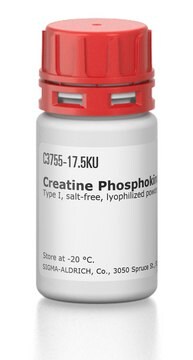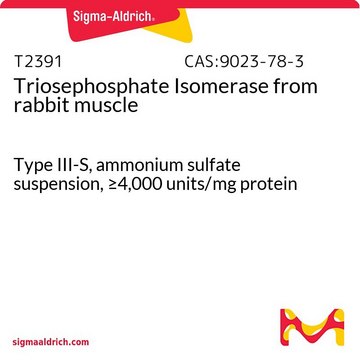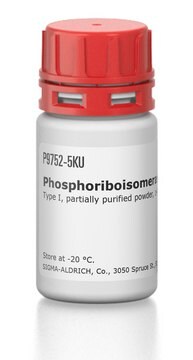P7634
3-Phosphoglyceric Phosphokinase from baker′s yeast (S. cerevisiae)
ammonium sulfate suspension, ≥500 units/mg protein
Sinónimos:
PGK, Phosphoglycerate kinase, 3-Phosphoglycerate kinase, ATP:3-Phospho-D-glycerate 1-phosphotransferase
About This Item
Productos recomendados
biological source
bakers yeast
Quality Level
form
ammonium sulfate suspension
specific activity
≥500 units/mg protein
storage condition
(Tightly closed)
concentration
1.0-10.0 mg/mL
foreign activity
Glyceraldehyde-3-phosphate dehydrogenase ≤0.1%
shipped in
wet ice
storage temp.
2-8°C
¿Está buscando productos similares? Visita Guía de comparación de productos
General description
Phosphoglycerate kinase (PGK), a glycolytic enzyme, is isolated from a broad variety of organisms. This typical hinge-bending monomeric enzyme is well-conserved among the three domains of life. The enzyme is made up of a single folded polypeptide chain that divides into two nearly identical domains, each linked by two -helices (-helices 7 and 14) and separated by a deep cleft. This arrangement gives the enzyme its distinctive bilobed structure.
Application
- to study low molecular weight GTP-binding proteins and mechanisms of inhibition of glyceraldehyde-3-phosphate dehydrogenase
- in the coupled assay to measure the backward activity of purified rabbit skeletal muscle nicotinamide adenine dinucleotide (NAD+)-dependent glyceraldehyde3-phosphate dehydrogenase (GAPDH)
- in the assay of glyceraldehyde-3-phosphate dehydrogenase
Biochem/physiol Actions
Unit Definition
Physical form
Analysis Note
Related product
signalword
Warning
hcodes
Hazard Classifications
Eye Irrit. 2
Storage Class
12 - Non Combustible Liquids
wgk_germany
WGK 2
flash_point_f
Not applicable
flash_point_c
Not applicable
ppe
Eyeshields, Gloves, type N95 (US)
Elija entre una de las versiones más recientes:
¿Ya tiene este producto?
Encuentre la documentación para los productos que ha comprado recientemente en la Biblioteca de documentos.
Los clientes también vieron
Artículos
Instructions for working with enzymes supplied as ammonium sulfate suspensions
Nuestro equipo de científicos tiene experiencia en todas las áreas de investigación: Ciencias de la vida, Ciencia de los materiales, Síntesis química, Cromatografía, Analítica y muchas otras.
Póngase en contacto con el Servicio técnico













